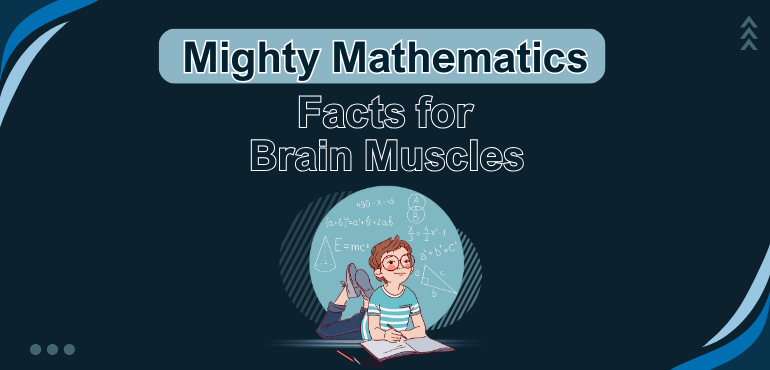
Mathematics is a fascinating subject that reveals the beauty and logic of the universe. However, mathematics also has some surprising and mind-blowing facts that challenge our intuition and common sense. Mathematics in MPC is an important subject if you are interested in pursuing it. In this article, we will explore 10 mathematics facts that will blow your mind.
Graham’s Number:
Did you know there is a number so big that it can’t be written down or even imagined? It’s called Graham’s number, and it’s related to a problem in geometry.
Graham’s number is so huge that even if you tried to write down each digit in the smallest possible font, you would run out of space in the observable universe. Even the number of digits in Graham’s number is too big to write down.
Möbius Strip:
Did you know there is a shape that has only one side and one edge? It’s called a Möbius strip, and it’s made by taking a rectangular strip of paper, giving it a half-twist, and joining the ends together.
If you trace your finger along the surface of a Möbius strip, you will go around both sides without crossing an edge. A Möbius strip can also be cut in half along its center line, and instead of getting two separate pieces, you will get one longer Möbius strip.
Four-Color Theorem:
Did you know there is a theorem that proves that any map can be colored with only four colors, such that no two adjacent regions have the same color? It’s called the four-color theorem, and it was first proposed in 1852 by Francis Guthrie, a student of mathematics.
The theorem was finally proved in 1976 by Kenneth Appel and Wolfgang Haken, using a computer program that checked over 1,000 cases. The four-color theorem has applications in cartography, graph theory, and computer science.
Champernowne’s Number:
Did you know there is a number that contains every possible combination of digits? It’s called Champernowne’s number, and it’s made by concatenating all the natural numbers in order: 0.12345678910111213141516…
Champernowne’s number is an irrational number, meaning it can’t be expressed as a fraction of two integers. It also has the property that any finite sequence of digits can be found somewhere in its decimal expansion. For example, your birthday, phone number, and social security number are all hidden in Champernowne’s number.
Cantor’s Diagonal Argument:
Did you know there is a paradox that shows that some infinities are bigger than others? It’s called Cantor’s diagonal argument, and it was devised by Georg Cantor, a pioneer of set theory. Cantor showed that the set of all natural numbers (1, 2, 3,…) is smaller than the set of all real numbers (numbers with decimals).
He did this by assuming that there is a one-to-one correspondence between the two sets, and then constructing a new real number that is not in the correspondence by changing one digit in each decimal place. This new number contradicts the assumption, and therefore proves that there are more real numbers than natural numbers.
Euler’s Identity:
Did you know there is a formula that connects five of the most important constants in mathematics? It’s called Euler’s identity, and it’s written as eiπ + 1 = 0.
In this formula, e is the base of natural logarithms, i is the imaginary unit, π is the ratio of a circle’s circumference to its diameter, 1 is the multiplicative identity, and 0 is the additive identity.
Euler’s identity is considered to be one of the most elegant and beautiful equations in mathematics, as it combines five seemingly unrelated constants into one simple relation.
Fibonacci Sequence:
Did you know there is a sequence of numbers that appears everywhere in nature? It’s called the Fibonacci sequence, and it’s made by adding the previous two terms to get the next term: 1, 1, 2, 3, 5, 8, 13,…
The Fibonacci sequence can be found in many natural phenomena, such as the arrangement of petals on a flower, the spiral of a snail shell, the branching of a tree, and the growth of a pineapple.
The Fibonacci sequence also has a close connection to the golden ratio, which is another mathematical constant that appears in art and architecture.
Halting Problem:
Did you know there is a problem that can’t be solved by any algorithm?. It’s called the halting problem, and it asks whether there exists a general method to determine whether any given computer program will eventually stop or run forever.
Alan Turing proved in 1936 that such a method does not exist. He did this by showing that if there was such a method, then it could be used to create a paradoxical program that contradicts itself. The halting problem is one of the first examples of an undecidable problem, which is a problem that has no definite answer.
Riemann Hypothesis:
Did you know there is a conjecture that has been unsolved for over 150 years? It’s called the Riemann hypothesis, and it’s related to the distribution of prime numbers.
The Riemann hypothesis states that all the non-trivial zeros of the Riemann zeta function, which is a complex function that encodes information about prime numbers, have a real part equal to 1/2.
The Riemann hypothesis is one of the most important and difficult problems in mathematics, and it has many implications for number theory, cryptography, and physics. The Clay Mathematics Institute has offered a prize of $1 million for anyone who can prove or disprove the Riemann hypothesis.
Nim:
Did you know there is a game that can’t be won by any strategy? It’s called Nim, and it’s played by two players who take turns removing objects from piles. The rules are simple: there are any number of piles, each with any number of objects; on each turn, a player must remove at least one object from any pile; the player who takes the last object loses.
Nim is a game of perfect information, meaning that both players know everything about the game state at all times. However, Nim has a mathematical trick that guarantees that one player can always win, regardless of what the other player does. The trick is to use binary arithmetic and a concept called nim-sum, which is the exclusive OR operation applied to the number of objects in each pile. The player who can make the nim-sum zero on their turn has a winning strategy.
Conclusion:
These are just some of the amazing mathematics facts that will blow your mind. Mathematics is full of wonders and mysteries; you might want to boost your mathematics tips and tricks that challenge your understanding and imagination. Mathematics is not only helpful and practical but also fun and beautiful. You might be surprised by what you find.
Also read: 10th Class Maths Formulas pdf | All Chapters in One Place








